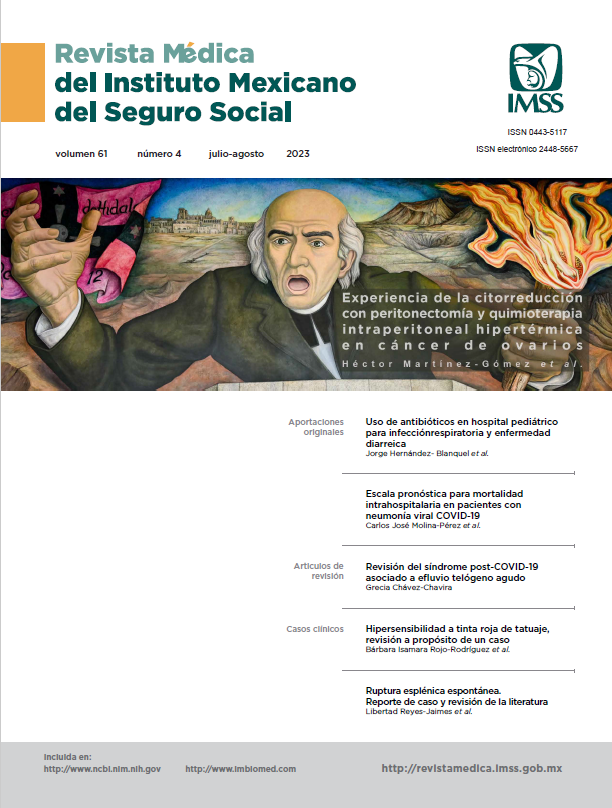Educational intervention on organ and tissue donation at UMAE No. 34
Main Article Content
Keywords
Transplantation, Tissue and Organ Procurement, Education, Community Participation
Abstract
Background: The lack of information associated with donation is devastating for those patients in need of a transplant and requires a solution based on changing social perception through educational interventions.
Objective: Determine the level of knowledge of the general population after an educational intervention about organ and tissue donation at the Hospital de Cardiología UMAE No. 34.
Material and methods: Educational intervention study with measurement before and after, prospective. Instrument validated using the Kuder-Richardson formula with a reliability coefficient of 0.74. The study population was made up of the general population in the waiting rooms at UMAE No. 34, only the associations with values of p < 0.05 were considered statistically significant.
Results: 266 evaluation instruments were applied to 133 participants. The educational intervention contributed to an increase in the level of knowledge (p = 0.0001). The level of knowledge after the intervention was higher in the younger participants (p = 0.013) and in those with a university studies (p = 0.0001). The relation between age and the level of subsequent knowledge showed favorable significance in the intention to donate in younger participants with high subsequent knowledge (p = 0.046).
Conclusions: An educational intervention on donation of organs and tissues for transplant purposes is an effective strategy to increase and reinforce the knowledge of the general population.
References
Vanholder R, Domínguez-Gil B, Busic M, et al. Organ donation and transplantation: a multi-stakeholder call to action. Nature Reviews Nephrology. 2021;17(8):554-568.
Lewis A, Koukoura A, Tsianos GI, et al. Organ donation in the US and Europe: The supply vs demand imbalance. Transplantation Reviews. 2021;35(2):100585.
Sierra-Mendoza R, López-Noguerola JS, Sosa-Bermúdez NE, et al. Donación de órganos desde una perspectiva del personal médico. Journal of Negative and No Positive Results. 2021;6(2):307-20.
Centro Nacional de Trasplantes [Internet]. Reporte anual 2021 de donación y trasplantes en México. México: CENATRA; 3 de enero de 2022 [consultado el 23 de Marzo de 2022]. Disponible en: https://www.gob.mx/cms/uploads/attachment/ file/692109/Anual2021.pdf.
Cantarovich F. Organ Donation in the 21st Century a Call for Social Care. Japan Journal of Clinical & Medical Research. 2022;128(2):2-8.
Vázquez-Gómez M, Moreno-Contreras S. Donación de órganos y tejidos con fines de trasplante, lo que un médico en formación debe conocer. Revista Mexicana de Trasplantes. 2018; 7(2):59-64.
Becker F, Roberts KJ, de Nadal M, et al. Optimizing organ donation: expert opinion from Austria, Germany, Spain and the UK. Annals of transplantation. 2020:25:e921727-1.
Argüero-Sánchez R, Sánchez-Ramírez O, Olivares-Durán EM. Donación de órganos y trasplantes en México, ¿Todo está resuelto?. Gaceta Médica de México. 2020;156(3):181-183.
Alavez-Maldonado DG, Gutiérrez-Beltrán GA, Quezada-Elvira VJ, et al. Donación en el Hospital de Cardiología No. 34. Revista Médica del Instituto Mexicano del Seguro Social. 2021;59(2):119-126.
Querevalú-Murillo W, Orozco-Guzmán R, Díaz-Tostado S, et al. Iniciativa para aumentar la donación de órganos y tejidos en México. Revista de la Facultad de Medicina. 2012;55(1): 12-17.
Rodríguez MJM, Cordero MJA, Villar NM, et al. Efectividad de las intervenciones educativas para la atención de la salud. Revisión sistemática. Medisur. 2017;15(1):71-84.
González-Sánchez J. Los niveles de conocimiento: El Aleph en la innovación curricular. Innovación educativa. 2014;14 (65):133-142.
Gunderson S. Donation Starts With a Decision: The Role of the Individual and Family in Organ Donation. Transplantation. 2019;103(5):864-865.
Zamora-Torres AI, Díaz-Barajas Y. Factores que inciden en la cultura de donación de órganos en Morelia, Michoacán: hacia una propuesta de política pública. Tla-melaua. 2018; 12(44):98-119.
Symvoulakis EK, Markaki A, Anyfantakis D, et al. Organ donation awareness: rethinking media campaigns. International Journal of Health Policy and Management. 2018;7(12):1165.
Constanzo-Fuentes JB, Rodríguez-Vidal M. Efectos de una intervención educativa frente a la actitud de donar órganos en escolares de la columna de Talcahuano. Enfermería Nefrológica. 2018;21(4):378-385.
Afshar R, Sanavi S, Rajabi MR. Attitude and willingness of high school students toward organ donation. Saudi Journal of Kidney Diseases and Transplantation. 2012;23(5):929.
Krupic F. The impact of religion and provision of information on increasing knowledge and changing attitudes to organ donation: an intervention study. Journal of religion and health. 2020;59(4):2082-2095.
Byrne M, Stainer B, Symington M, et al. School education to increase organ donation and awareness of issues in transplantation in the UK. PediatricTransplantation. 2019;23(5): e13492.
Arriola KRJ, Redmond N, Williamson DH, et al. A community based study of giving ACTS: organ donation education for African American adults. Journal of the National Medical Association. 2019;111(2):185-192.
Steenaart E, Crutzen R, Candel MJJM, et al. The effectiveness of an interactive organ donation education intervention for Dutch lower-educated students: a cluster randomized controlled trial. Trials. 2019;20(1):1-12.
Oz MC, Kherani AR, Rowe A, et al. How to improve organ donation: results of the ISHLT/FACT poll. The Journal of Heart and Lung Transplantation. 2003;22(4):389-410.
Riederer BM, Bolt SH, Brenner E, et al. The legal and ethical framework governing body donation in Europe: 1st update on current practice. Europena Journal of Anatomy. 2012;16 (1):1-21.
Molina-Pérez A, Rodríguez-Arias D, Delgado-Rodríguez J, et al. Public knowledge and attitudes towards consent policies for organ donation in Europe: A systematic review. Transplantation Reviews. 2018;33(1):1-8.
Bani M, Mazza U, Valsecchi M, et al. The impact of multiorgan procurement surgery in the nursing team: An Italian qualitative study. Death studies. 2021;45(5):354-360.


